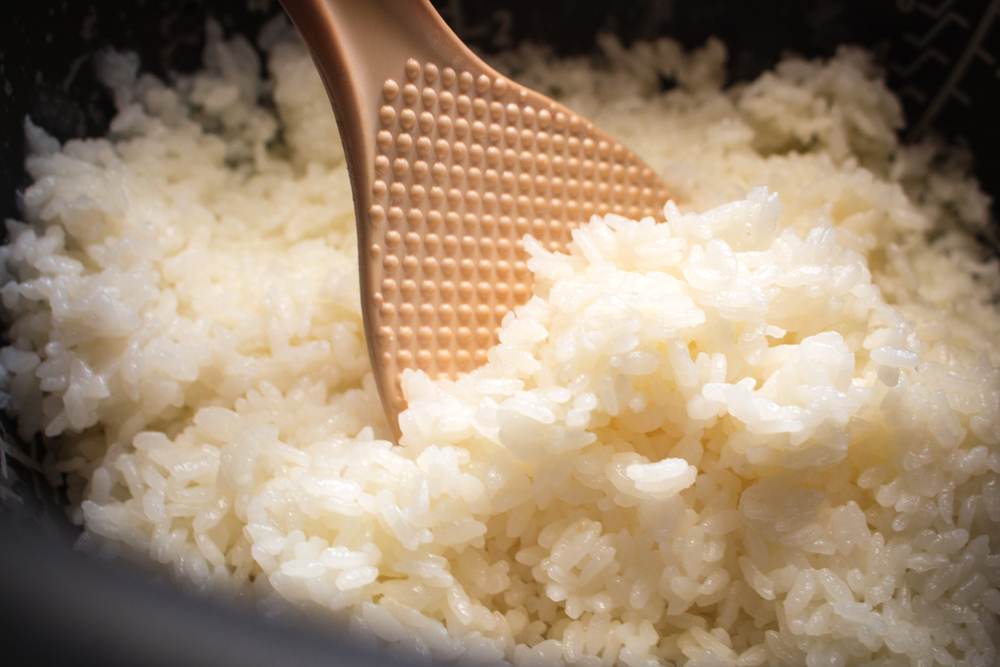If you’ve ever purchased a rice cooker, you may have noticed a surprise addition in the box.
It’s a rice paddle, and it looks like a wide, flat spatula with a round head and small handle.
It is typically made of plastic or wood.
In Japan, they are called “shamoji,” and they are a kitchen staple. So don’t toss it into the utensil drawer with other rarely used spatulas
. Keep it alongside the rice cooker, which will keep the appliance in good condition while significantly improving the rice’s texture.
The purpose of the rice paddle
 Source: Shutterstock
Source: Shutterstock
Rice cookers are lined with a nonstick coating, which means they should only be used with certain types of utensils, namely plastic and wood.
Tools made of metal and similarly hard materials can scratch and scrape the coating, making it peel off and become ineffective.
So the cooker comes with its own rice paddle that’s safe to use with the main product.
Simply put, the rice paddle is meant to stir, scoop, and serve rice — all without mashing up the grains.
When using a rice cooker, it’s good to stir the rice when the cooking cycle is over.
This step helps release excess moisture and maintain a consistent texture throughout the dish.
The paddle comes ready to do this while maintaining the fluffiness.
It’s also helpful for mixing vinegar into the rice when making sushi.
Should you get a rice cooker?
 Source: Shutterstock
Source: Shutterstock
The paddle aside, rice cookers can be game-changer if you make rice frequently or aren’t confident with cooking rice on the stove. The cooking method is simple; the cooking bowl heats to a boiling temperature and then automatically turns lower or off when the rice is complete. The product comes with a guide on how much water to add based on the type and size of the rice, making the process even more foolproof.
“I love [a rice cooker] because it takes all the guesswork out of making perfect rice,” said Dale Talde, chef and owner of Goosefeather. “It’s a must-have appliance because even if you happen to put in too much water or not enough, it adjusts to help make perfect rice.”
Not only that. But rice cookers can also cook curries and stews. In face, some version have a setting specifically for these types of dishes. Some also come with settings for quick-cook and delay start so you can plan meals in advance or last minute.
Always rinse!
 Source: Shutterstock
Source: Shutterstock
One of the most important rice-making tips is to rinse the uncooked grains until the residue comes off and the water runs clear. It reduces the amount of arsenic in the rice as well as removes particles of dust, dirt, and bran. “I’ve seen how they collect rice in the paddies and how it’s processed in the factories,” says Min Kim Bryant, a market analyst at CR. “The same reason I wash my produce is why I wash my rice.”
For thick grains such as wild rice, sushi rice, or brown rice, some experts recommend soaking them for about half an hour to help soften them.
Cooking rice on the stove
 Source: Shutterstock
Source: Shutterstock
Whether you have a cooker or not, it’s good to know how to make rice on the stove. Start by choosing a large pot. “Many people cook rice in these itty-bitty teeny little pots and wonder why the bottom is overcooked, and the top is undercooked,” says JJ Johnson, chef and owner of Fieldtrip, a rice-focused eatery in New York. “It’s because the rice doesn’t have room to expand.”
Also, unlike cookers, you should be exact when you’re working with the stove. Use a ratio of:
1½ cups of water for 1 cup of long-grain white rice
1¼ cups of water for sushi rice
2¼ cups of water for short-grain brown rice
Then, bring the rice and water to boil over high heat before lowering it. Cover the pot and let it simmer until the water is fully absorbed. For white rice, set a timer for 20 minutes and 45 minutes for brown rice. Take the pot off of the heat and let it stand for 10 minutes, then fluff it — using a paddle if you have one.
More rice cooking tips
 Source: Shutterstock
Source: Shutterstock
For a flavor boost, cook the rice with broth or a mix of water and coconut milk. You can also add spices to the pot, such as saffron or turmeric.
Never stir the grains while they’re cooking.
Add a splash of oil to prevent the grains from sticking together when cooking on the stovetop.
Toast freshly cooked stovetop rice by adding a bit of oil to the pan and sautéing.
Cook a large batch of rice, separate it into meal-sized portions, and freeze it for a future recipe. Reheat it in the microwave with an additional tablespoon of water or warm it in a saucepan with a splash of oil or water.
Use day-old rice for rice pudding, bulking up soups or stews, and fried rice.
News
These 12 Children Proved Once Again That Any Child Can Be A Hero
Heroes Among Us: The Awesome Dozen Kids Aid Police It is universally acknowledged by those who witnessed the event that the group of children we are celebrating…
People who have this line on their hand are very special.
Palmistry is a form of divination that has been passed down from generation to generation. It was first used in China and India more than 5,000 years…
There’s a Woman in a Boat Riddle: Try to Solve the Viral Riddle
There is no shortage of education and entertainment. Thanks to smartphones, it’s all at our fingertips. Even with all the variety, spending a few minutes on riddles…
Astronaut shares the profound ‘big lie’ he realized after seeing the Earth from space
Have you ever heard of the overview effect? This refers to the perspective that astronauts experience when looking at the Earth from outer space. The effect is…
Eerie Photos Shows The Deadliest Object On Earth That Can Kill You Just By Being Near Near it For Minutes 5 Minutes
The Chernobyl disaster of 1986 left behind a legacy of devastation, not least of which includes what is now considered the deadliest object on Earth: the Elephant’s Foot….
Breadcrumbing: The Dating Trend That Needs to End
Like most trends, dating trends come and go, which is good news in most cases. For example, being ghosted feels terrible and confusing. Meanwhile, catfishing does both and…
End of content
No more pages to load









